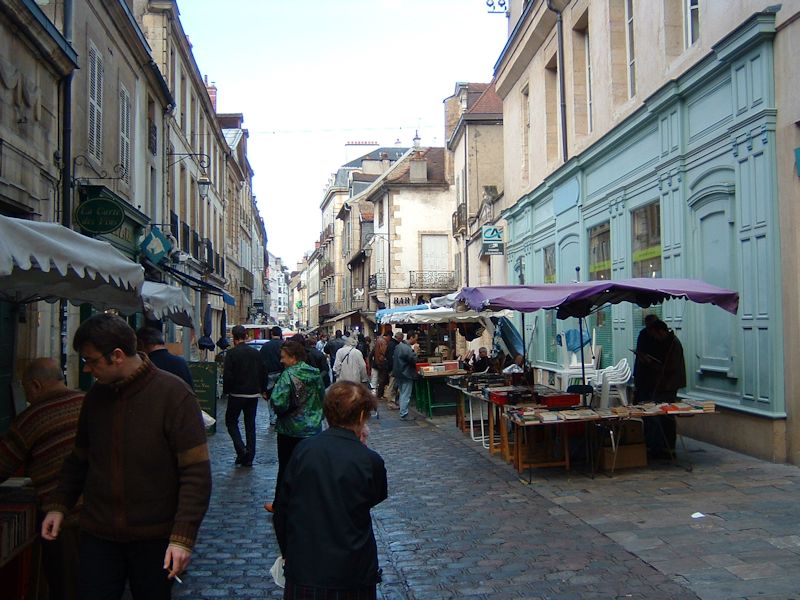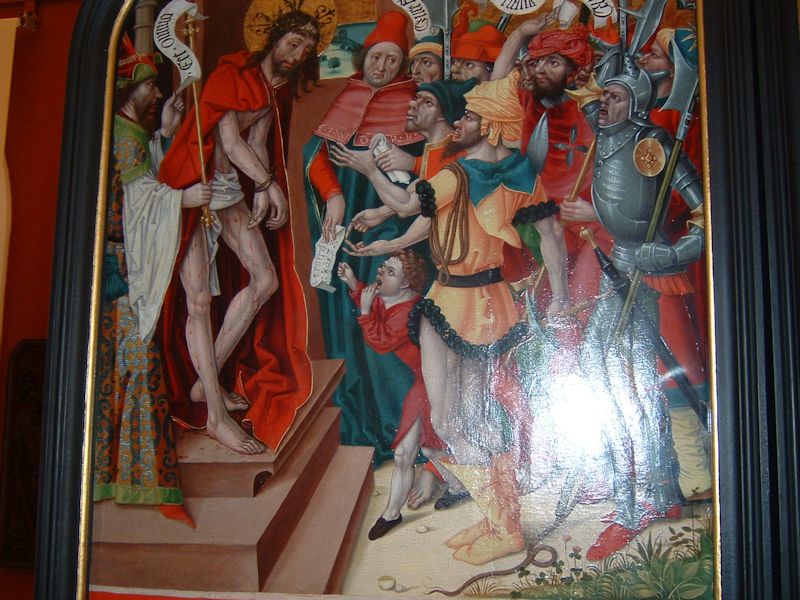
Nicely
checked into the Hotel Philippe Le Bon on 21 October
2005, we gaze out upon the neighborhood in anticipation . . .

Oh,
this is going to be a NICE town!

We're
in the very old (15th century) and lovely Hotel Philippe Le Bon on the rue Ste
Anne on the very edge of the Historic Old Town. Traveling companion Kristin has
a genius for finding these places on the Web -- moderate prices, heavy-duty historical
ambience, an experience in itself. The attached "Wine-lovers" restaurant
was exceptionally superb for a one-off, but way out of this respondent's normal
price range, so on succeeding evenings we walked up the street to the kebab stand.

At this
point, in early evening, whilst looking for the falafel stand, we're catching
up on the brochures, to the effect that Philippe Le Bon, or "the Good"
(1396-1467), was the Duke of Burgundy for much of the 15th century (1419-1467),
and more or less made the ancient Roman Divio into the capital of the Bourgogne
or Burgundy region.

The
Old LeBon himself, with his cute haircut, seems to have got more interested in
conquering the Netherlands and may not have spent much time here, but we're all
the better for his attention, because the Dijon old town is a wonder.
(Phil's
son, Charles the Bold, by the way, is the Burgundian Duke who tried to conquer
western Switzerland and got his butt handed to him in 1476.)

A lot
of these overhanging half-timbered buildings date from the mid-12th to the 15th
centuries, so when photographing their captivating historic lines we tend to edge
on over to the far side of the street, just in case.

The cathedral
of Notre Dame, completed in about 1240, dominates this part of the old city, but
it's far from the only game in town in the "ville aux
cent clochers", the city of a hundred bell-towers.

An
amazing array of very sad faces across the front of the church.
These are not the original gargoyles; the story is told that one of the original
gargoyles fell off and snuffed a moneylender who was passing below. The other
moneylenders banded together and persuaded the authorities to remove all the rest,
and the present figures were only added in 1881. Source for that: http://dijoon.free.fr/bestof/notre-dame.htm.

Kristin
(green jacket) checking out some pre-breakfast bargains in the market. (The sole
drawback of the Hotel Philippe Le Bon is that breakfast costs €13 extra,
so we'll be much happier with a croissant in the bar-café in the market.
The one next to the kebab stand.)

That's
the Jacquemart family sitting up there on the clock -- the guy with the pipe adorned
the belfrey in Courtrai, Belgium, until a Burgundian duke crated him up and brought
him to Dijon in 1382. Mom on the right (Jacqueline) was added in the 1600s, the
young lad Jacquelinet was added in 1716, and little Jacquelinette came along in
1881.
Studies
in the complicated verticality of the Notre-Dame.


Just
behind the cathedral de Notre-Dame, a fine little restaurant just up the stairs
behind Kristin (green jacket), who's memorizing the menu to come back in the evening.

Half-timbered
buildings near the cathedral.


The
gargoyles were at the head end of the cathedral. This is its butt.

Coming
soon: a 15th century house with all the mod cons.

All of
the Dijon old town has been lovingly restored and, at least in the off season,
it is a perfect joy to wander through, looking for a kiosk that carries the International
Herald Tribune. Only Superman could have managed all this skilled restoration
in a reasonable time frame.

Oh,
there's Superman now. And a Red Indian.

This
is the former Place Royale in front of the Dukes' Palace, now called the Place
de la Libération since you know when.
And these folks seem to be about as liberated as we'd like to find in broad daylight
on the high street.

Here,
in fact, are the Blues Brothers, preparing to drop their trousers. (The human
carrot at the top of this page was unwisely encouraging these guys at the time.)

The Place
de la Libération, with the ducal palace behind, and the Blues Brothers
dropping their trousers for the start of the race. The man in the foreground is
wearing a stylish white garbage bag. One common feature of Volks marathons is
the ubiquitous plastic garbage bag, which warms one but can be doffed and discarded
when the starting gun sounds.
More
than once this narrator has responded to the starting gun in the Morat-to-Fribourg
running race by wading kneedeep with 2000 other age-group runners through black
plastic garbage bags for five minutes before reaching the starting line and passing
out of the medieval city gate.

Several
convicts, a colorful tiger, and a man wearing balloons are viewed from the first
floor windows of the exceptionally wonderful Musée des Beaux-Arts next
door.

The
starting gun sounds, and the Vikings are off.

Great
stuff in the Musée des Beaux-Arts, especially Burgundian stuff, naturally,
from the heyday of the late 15th century. Here's Jesus regretting everything in
one of an imaginative series of passion week paintings featuring local residents
all looking like hideous warty bestial freaks.

Terrible
luck so far

This
gentleman sits in the courtyard between the palace and the museum and plays his
ukelele, whilst his son plays with the cobblestones. From time to time, he moves
to another bench, and the kid comes along and finds new cobblestones to play with.

The
market around the Grande Halle du Marché, which is just out of sight to
the left but ugly.

Downtown
congestion

Brave
kids on the bungeymobile in the Place de la Libération. Nearly every seven-year-old
was able to do the triple somersault after a half-minute's practice.

The view
to the west from the Philippe-le-Bon tower of the Ducal Palace, said to be 316
steps to the top but a more careful count during our visit in October 2005 revealed
that there are really more than 7,000 of them.
(Many
of Dijon's outlying suburbs were missed in the present visit, but got pretty well
crisped in the ethnic Sarkozy-riots in the banlieues shortly after we'd vacated
the area. We were mainly interested in the historic old town anyway.)

Notre-Dame,
next door, from the top end.

The Place
de la Libération some 7,000 steps below, with the bungeymobile on the left,
the pony rides in the centre, and the bouncey castle on the right. Superman, the
Blues Brothers, and the Vikings are halfway to the next town by now.

Rooftops,
with the two towers of Saint-Bénigne (93 meters high!) just right of center.
That's a 13th-century modernism built up after the 6th century church fell down
-- the old crypt's still there, and probably many an ugly tale could be told about
it.

St. Benignus,
by the way, after whom that church was named, was a 2nd century "Asiatic
priest" who labored long in Burgundy knocking on doors and accosting people
(the Lignones, they were called then) on the streetcorners trying to convince
them to become Christians, sort of like early Jehovah's Witnesses or Mormon teams
in their cheap suits and sacred underpants. (The medieval story of Benignus' miracles
turned out to have been ripped from the exploits of some other Christian guy in
Turkey. But never mind.)

A
chilly October day to be posing bronzely out in the piazza with no clothes on.

Kristin
says goodbye to the Philippe Le Bon and heads for home. Or for Besançon,
in fact.
Those interested in the very recommendable Hotel Philippe Le Bon can consult its
own Web site http://www.hotelphilippelebon.com/.